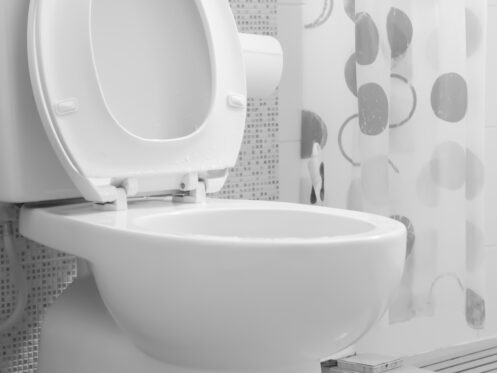There are numerous ways to make your home more energy-efficient. Using smart thermostats can save you a considerable amount of energy and reduce heating and cooling costs. Upgrading the home’s insulation can increase HVAC efficiency as well. Replacing old appliances with energy-efficient models is key to saving as much energy as possible. When deciding which appliances to upgrade, it’s important to go room by room. In the bathroom, one of the most important upgrades you can make is to switch to low-flow toilets.
Types of Low-Flow Toilets
Low-flow toilets are innovative fixtures designed to conserve water by reducing the amount used for each flush when compared to traditional toilets. There are two primary types of low-flow toilets. Understanding their differences will help you choose the best type for your home. These toilets utilize various mechanisms to achieve water savings while maintaining effective waste removal.
Single-Flush Low-Flow Toilet
One type is the single-flush low-flow toilet, which employs a consistent water volume for every flush, typically ranging from 1.28 to 1.6 gallons (4.8 to 6 liters) per flush. Despite offering a single-flush option for both liquid and solid waste, single-flush toilets still significantly reduce water consumption compared to older models.
Dual-Flush Low-Flow Toilet
Dual-flush low-flow toilets provide users with two flush options: a low-volume flush for liquid waste and a higher-volume flush for solid waste. This design allows users to select the appropriate flush strength based on the type of waste, further maximizing water efficiency. Dual-flush toilets typically use around 0.8 to 1.6 gallons (3 to 6 liters) for the low-volume flush and 1.6 to 2.0 gallons (6 to 7.5 liters) for the high-volume flush.
Maintenance Requirements for Low-Flow Toilets
Low-flow toilets don’t normally require very much upkeep. To keep them running well, simply clean the tank and bowl regularly to remove dirt and mineral deposits. If you ever notice a leak or the toilet doesn’t flush correctly, contact a plumber right away. Professional maintenance checks and repairs keep everything running smoothly and reliably.
Cost of Low-Flow Toilets Compared to Regular Ones
Low-flow toilets typically cost slightly more upfront compared to regular toilets due to their advanced water-saving features and technology. However, the long-term savings on water bills can offset this initial expense. Additionally, many municipalities offer rebates or incentives for installing low-flow toilets, further reducing the overall cost.
Benefits of Low-Flow Toilets
Taking the time to understand the benefits of low-flow toilets can help you create a more sustainable home. If you decide to install one, it’s very important to hire a plumber. Plumbers know how to ensure a proper fit and tight seal. They can easily address potential issues with water pressure or drainage.
Water Conservation
While older toilets can use around 3.5 to 7 gallons (13 to 26 liters) of water per flush, low-flow toilets consume much less. A single-flush, low-flow toilet can result in water savings of 50% or more. Dual-flush, low-flow toilets offer even greater water savings. Overall, the water savings achieved by low-flow toilets can amount to hundreds or even thousands of gallons per household each year. This means the home will use less energy for water transportation and water treatment. As a result, the home will emit fewer carbon emissions. This is especially important since water heating accounts for a large amount of home energy use. From a financial standpoint, water conservation can cut monthly water costs in half.
Longer Plumbing Lifespan
Low-flow toilets reduce wear and tear on pipes, seals and valves by lowering water flow with each flush. The reduced amount of water in each flush also minimizes the risk of corrosion and erosion, which are common causes of plumbing system deterioration. An additional feature of low-flow toilets is their effective flushing mechanism, which keeps water pressure just right while using less water overall. With less stress on the pipes and fittings, there’s a smaller chance of leaks, bursts and other plumbing disasters.
Higher Property Value
Low-flow toilets demonstrate a conscientious commitment to environmental stewardship. They are especially appealing to sustainability-conscious homeowners. In areas where water conservation is paramount or legally mandated, these fixtures will enhance the property’s allure. Furthermore, homes boasting low-flow fixtures may qualify for coveted green construction certifications or incentives, elevating their market desirability.
Reduced Risk of Sewage Overflow
There are major risks to human and environmental health from sewage spills. They can easily contaminate water sources and make you sick. Sewage overflows greatly contribute to the spread of diseases, pollution and costly cleanup efforts. Moreover, they can damage your home, resulting in expensive repairs. Low-flow toilets help mitigate the risk of sewage overflows by reducing the volume of water entering sewage systems with each flush. This is particularly beneficial for minimizing the likelihood of backups and overflows during heavy rainfall or high-demand periods.
Less Likely to Clog
Low-flow toilets use efficient flushing mechanisms to create a strong, focused flush. This pushes the waste efficiently through the drainpipes, minimizing the risk of blockages. Some low-flow toilets even feature larger trapways and smoother internal surfaces. These features reduce the likelihood of waste accumulation and blockages within the toilet itself. Moreover, the reduced water volume in each flush means less water enters the drainage system at once. This also decreases the risk of overwhelming the pipes and causing clogs.
Healthier Septic Systems
A low-flow toilet reduces the amount of water going into the septic tank with every flush. This helps the system avoid overload and possible breakdowns. It also aids in keeping the tank’s microbiome in check, which speeds up waste digestion and prevents sediments from building up. Plus, less water entering the system equals less septic tank pumping, which reduces maintenance costs and inconveniences. Pairing low-flow toilets with annual septic system inspections is the best way to maintain a healthy septic system.
Adaptability to Retrofitting
Due to their standardized sizes and configurations, low-flow toilets can easily replace older, less efficient fixtures. Even better, they can replace them without requiring extensive modifications to existing plumbing infrastructure. This makes them an ideal choice for homeowners looking to upgrade their bathrooms for improved water efficiency and sustainability. Additionally, low-flow toilets come in a variety of styles and designs to suit different aesthetics and preferences. This makes it simple to enhance the functionality and appearance of bathrooms while reducing water consumption.
Become LEED Certified
Using low-flow toilets that save water bolsters a home’s eligibility for LEED certification. LEED certification is a prestigious designation awarded to residential properties that meet specific criteria. These criteria usually relate to the home’s site selection, water efficiency, energy performance and use of materials. Achieving LEED certification signifies your commitment to environmental responsibility and sustainable living practices. Installing solar panels, air-sealing your house and optimizing natural light and ventilation are other LEED certification options.
Cal’s Plumbing specializes in making homes more comfortable and energy efficient. We provide plumbing inspections, toilet installations, water leak detection, drain replacement, hydrojetting, and more. To install low-flow toilets in your Tucson, AZ, home, call us today.





